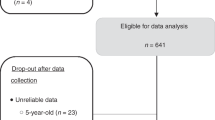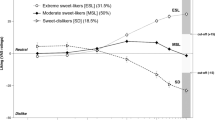Abstract
Background:
The 5-year multilevel epidemiological IDEFICS (Identification and prevention of dietary- and lifestyle-induced health effects in children and infants) study, launched under the Sixth Framework Programme of the European Commission, aims at counteracting the epidemic of dietary- and lifestyle-induced adverse health effects in children. To reveal possible links between overweight/obesity in childhood with taste sensitivity and taste preferences, special procedures were developed for application at the European level. This paper presents these newly developed procedures.
Methods:
Testing procedures to assess taste sensitivity for sucrose, sodium chloride, caffeine and monosodium glutamate and taste preferences for sweet, flavour, salty, fatty and umami tastes were developed with 191 children from nursery schools and preschools in northern Germany. To assess test–retest reliability, Cohen's kappa was calculated.
Results:
The study shows that it is possible to assess taste sensitivity and taste preferences even in young children, provided the framework of the procedures applied is adapted to this scenario. Test–retest reliability was calculated for the procedures applied and the results show that they are very reliable for assessing taste preferences and taste sensitivity in young children.
Conclusion:
It is possible to assess taste sensitivity and taste preferences even in young children, provided the methods applied are adapted to the special requirements that working with young children entail.
This is a preview of subscription content, access via your institution
Access options
Subscribe to this journal
Receive 12 print issues and online access
$259.00 per year
only $21.58 per issue
Buy this article
- Purchase on Springer Link
- Instant access to full article PDF
Prices may be subject to local taxes which are calculated during checkout


Similar content being viewed by others
References
Wang Y . Child obesity and health. In: Kris H (ed). International Encyclopedia of Public Health. Academic Press: Oxford, 2008, pp 590–604.
Ahrens W, Bammann K, de Henauw S, Halford J, Palou A, Pigeot I et al. Understanding and preventing childhood obesity and related disorders—IDEFICS: a European multilevel epidemiological approach. Nutr Metabol Cardiovasc Dis 2006; 16: 302–308.
Guinard JX . Sensory and consumer testing with children. Trends Food Sci Technol 2000; 11: 273–283.
Kimmel S, Sigman-Grant MJ, Guinard JX . Sensory testing with young children. Food Technol 1994; 48: 92–99.
El-Chaar GM, Mardy G, Wehlou K, Rubin LG . Randomized, double blind comparison of brand and generic antibiotic suspensions: II A study of taste and compliance in children. Pediatr Infect Dis J 1996; 15: 18–22.
Hopkins B . The Cambridge encyclopedia of child development. In: Barr RG, Michel GF, Rochat P (eds). The Cambridge Encyclopedia of Child Development. Cambridge University Press: Cambridge, New York, Melbourne, Madrid, Cape Town, Singapore, Sao Paulo, 2005.
Wadsworth BJ . Piaget's Theory of Cognitive and Affective Development, 3rd edn. Longman: New York, 1984.
Palisin H . Preshool temperament and performance on achievement tests. Dev Psychol 1986; 22: 766–770.
Simonds JF, Simonds MP . Cross validity of the behaviour style questionnaire and child personality scale in nursery school children. J Clin Psychol 1982; 38: 328–332.
Tzuriel D, Klein PS . Learing skills and types of tempraments as discriminants between intrinsically and extrinsically motivated children. Psychol Rep 1983; 53: 59–69.
Kroll BJ . Evaluating rating scales for sensory testing with children. Food Technol 1990; 44: 78–86.
Ahrens W, Bammann K, Siani A, Buchecker K, De Henauw S, Iacoviello L et al. The IDEFICS cohort: design, characteristics and participation in the baseline survey. Int J Obes 2011; 35 (Suppl 1): S3–S15.
Visser J, Kroeze JHA, Kamps WA, Bijleveld CMA . Testing taste sensitivity and aversion in very young children: development of a procedure. Appetite 2000; 34: 169–176.
Linschoten MR, Harvey LO, Eller PM, Jafek BW . Fast and accurate measurement of taste and smell thresholds using a maximum-likelihood adaptive staircase procedure. Percept and Psychophys 2001; 63: 1330–1347.
Rangan C, Barceloux DG . Food additives and sensitivities. Dis Mon 2009; 55: 292–311.
Landis JR, Koch GG . The measurement of observer agreement for categorial data. Biometrics 1977; 33: 159–174.
Popper R, Kroll JJ . Conducting sensory research with children. J Sen Stud 2005; 20: 75–87.
Zhang Z, Tannan V, Holden J, Dennis R, Tommerdahl M . A quantitative method for determining spatial discriminative capacity. BioMed Eng Online 2008; 7: 12.
Glanville EV, Kaplan AR, Fischer R . Age, sex and taste sensitivity. J Gerontol 1964; 19: 474–478.
Yasaki T, Miyashita N, Ahiko R, Hirano Y, Kamata M . Study on sucrose taste thresholds in children and adults. J Dent Health 1976; 26: 200–205.
James CE, Laing DG, Oram N . A comparison of the ability of 8-9-year-old children and adults to detect taste stimuli. Physiol Behav 1997; 62: 193–197.
Plattig KH . The sense of taste. In: JR Pigott (ed). Sensory Analysis of Foods. Elsevier Science Publishers: London, 1984, pp 1–22.
Léon F, Couronne T, Marcuz MC, Köster EP . Measuring food liking in children: a comparison of non verbal methods. Food Qual Pref 1999; 10: 93–100.
Kim UK, Breslin PAS, Reed D . Genetics of human taste perception. J Dent Res 2004; 83: 448–453.
Yokomukai Y, Cowart BJ, Beauchamp GK . Individual-differences in sensitivity to bitter-tasting substances. Chem Senses 1993; 18: 669–681.
Acknowledgements
This study was conducted as part of the IDEFICS study (http://www.idefics.eu). We gratefully acknowledge the financial support of the European Community within the Sixth RTD Framework Programme Contract No. 016181 (FOOD). We also thank Mr Hermann Pohlabeln for his support in compiling the statistics.
The information in this document reflects the author's view and is provided as is.
Author information
Authors and Affiliations
Consortia
Corresponding author
Ethics declarations
Competing interests
The authors declare no conflict of interest.
Additional information
Statement of ethics
We certify that all applicable institutional and governmental regulations pertaining to the ethical use of human volunteers were followed during this research. Approval by the appropriate ethics committee was obtained by the centres carrying out the fieldwork. Participating children did not undergo any study procedure before both they and their parents gave their consent for examinations, collection of samples, subsequent analysis and storage of personal data and collected samples. The children and their parents could consent to single components of the study while refraining from others.
Rights and permissions
About this article
Cite this article
Knof, K., Lanfer, A., Bildstein, M. et al. Development of a method to measure sensory perception in children at the European level. Int J Obes 35 (Suppl 1), S131–S136 (2011). https://doi.org/10.1038/ijo.2011.45
Published:
Issue Date:
DOI: https://doi.org/10.1038/ijo.2011.45
Keywords
This article is cited by
-
Sensory taste preferences and taste sensitivity and the association of unhealthy food patterns with overweight and obesity in primary school children in Europe—a synthesis of data from the IDEFICS study
Flavour (2015)
-
Taste preferences in association with dietary habits and weight status in European children: results from the IDEFICS study
International Journal of Obesity (2012)
-
Children's taste perception and cognitive development
International Journal of Obesity (2012)
-
Reply to Finistrella et al
International Journal of Obesity (2012)
-
Ernährungs- und lebensstilbedingte Erkrankungen bei Kindern
Bundesgesundheitsblatt - Gesundheitsforschung - Gesundheitsschutz (2012)



